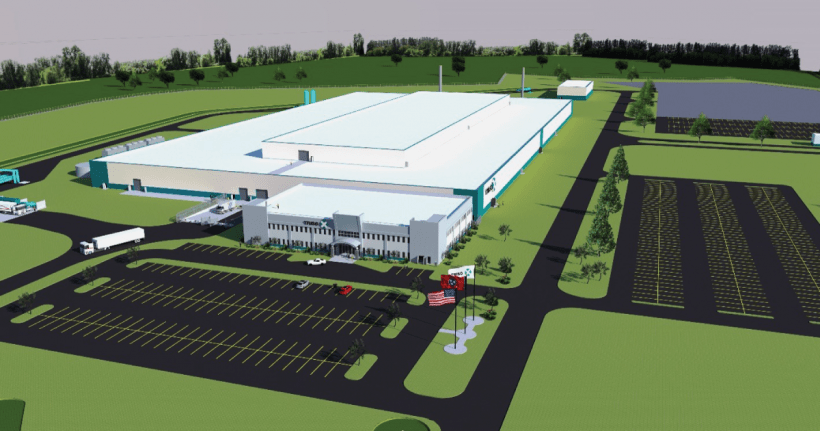Hanford waste tanks moved for disposal

Two large tanks near the Effluent Treatment Facility (ETF) at the Department of Energy’s Hanford Site in Washington state were removed recently to make way for future wastewater treatment activities at the ETF.

A message from Goodway Technologies
Optimizing Maintenance Strategies in Power Generation: Embracing Predictive and Preventive Approaches

Two large tanks near the Effluent Treatment Facility (ETF) at the Department of Energy’s Hanford Site in Washington state were removed recently to make way for future wastewater treatment activities at the ETF.

O'Quinn
Nuclear Newswire erroneously reported this morning that the Virginia Senate’s Finance and Appropriations Committee on February 15 advanced legislation that included nuclear in a list of energy technologies that would receive research and development funding through a Virginia Power Innovation Fund. In fact, the bill, H.B. 2386, was approved after the committee had stripped nuclear from the list. NN regrets the error.
Following the finance panel’s vote, Del. Israel O’Quinn (R., 5th Dist.), the bill’s sponsor, expressed his disappointment. “The knee-jerk opposition to nuclear innovation is very short-sighted and puts Virginia behind the curve on energy diversification,” he said. “Nuclear energy is inevitably going to have to be a bigger part of Virginia’s energy portfolio. It produces zero carbon and is highly reliable.”

Entergy’s River Bend nuclear power plant started its 22nd scheduled refueling and maintenance outage on February 11. The plant, located in St. Francisville, La., is a 967-MWe General Electric boiling water reactor.

As if being stuck in the middle of a combat zone isn’t sufficiently nerve-racking, workers at Ukraine’s Zaporizhzhia nuclear power plant—under Russian occupation since last March—must now concern themselves with having access to enough water to keep the facility safe.
The Defense Waste Processing Facility (DWPF) at the Department of Energy’s Savannah River Site (SRS) in South Carolina has resumed operations after a completing a processing improvement that the DOE said will enable safer operations and more efficient vitrification of radioactive waste.

Nick Touran
I got into nuclear engineering when I realized I could apply my passion for computers to the critical human challenge of energy. After training, I spent the past 13-plus years building automated and integrated engineering analysis tools for the efficient design/licensing of advanced nuclear reactors. Given what I’ve seen, I expect that modern high-level programming languages and data systems will continue to enable new efficiencies in analysis, configuration management, work planning, procurement, training, compliance, and execution in operations. The magnitude of potential impact laid out, for example, in Information Technology for Nuclear Power Plant Configuration Management (IAEA-TECDOC-1651) is well within reach. These impacts are identical to those promised by digital twins. Achieving these goals will require more information workers in the offices of nuclear vendors and operators to develop sophisticated skills in software engineering, database administration, statistics, and business analytics. Additionally, decision makers must be better trained to best understand and choose specialized IT systems and software.

Salado Isolation Mining Contractors (SIMCO), a single-purpose entity comprised of Bechtel National and Los Alamos Technical Associates as a teaming contractor, has assumed responsibility for managing and operating the Waste Isolation Pilot Plant in New Mexico.
The United States is supporting a junior professional officer (JPO) position in the International Atomic Energy Association to work on spent nuclear fuel management. The role is for an associate project officer-spent fuel management, who will be based in Vienna, Austria, and work under the direct supervision of the technical leader of the spent fuel management team in the Division of Nuclear Fuel Cycle and Waste Technology.
The Nuclear Regulatory Commission has updated its guidance for nuclear power plant owners and operators in estimating the cost of decommissioning their reactors. Licensed power reactor operators are required under NRC regulations to annually adjust the estimated costs (in current-year dollars) of decommissioning their plants to ensure that adequate funds are available when needed.
 The new ANS STEM Academy launched at the end of 2022 encompasses all of the American Nuclear Society’s educational programs. It brings together a state-of-the-art curriculum with nuclear experts and enriches classroom experiences to enable a national expansion of K-12 nuclear science and technology education. The new program strives to serve educators, students, and everyone interested in nuclear science and technology.
The new ANS STEM Academy launched at the end of 2022 encompasses all of the American Nuclear Society’s educational programs. It brings together a state-of-the-art curriculum with nuclear experts and enriches classroom experiences to enable a national expansion of K-12 nuclear science and technology education. The new program strives to serve educators, students, and everyone interested in nuclear science and technology.
Citing a lack of jurisdiction, the 10th U.S. Circuit Court of Appeals in Denver has dismissed a petition by the state of New Mexico challenging the Nuclear Regulatory Commission’s licensing of Interim Storage Partners’ (ISP) consolidated interim storage facility (CISF) in Andrews County, Texas.

In remote southeastern Washington you will find the sprawling Hanford Site, which was constructed to produce plutonium for the Manhattan Project. Within this complex is the first plutonium production reactor, the Hanford B Reactor. The DuPont Corporation was responsible for construction and operation of the B Reactor. Due to the urgency of the Manhattan Project, construction was completed in just over a year, and The B Reactor went critical on September 26, 1944. After the needs of the Manhattan Project were satisfied, the reactor was briefly shut down and then restarted to produce plutonium for roughly another 20 years, supporting Cold War efforts. In addition to plutonium production, the B Reactor also pioneered the process to produce tritium for the first-ever thermonuclear test.

The Roy G. Post Foundation is making about $100,000 in funding available to colleges and universities near Department of Energy sites. The funds will be used for education support, with a particular focus on minority-serving institutions.

A key component needed for the National Spherical Torus Experiment–Upgrade (NSTX-U), the flagship fusion facility currently under repair at the Department of Energy’s Princeton Plasma Physics Laboratory (PPPL), has been delivered to the lab’s New Jersey campus.

The United Kingdom’s nuclear industry is expanding, with the U.K. government committed to supporting the build of more civil nuclear power plants (deployments up to 24 GW by 2050)1 while also undertaking large-scale decommissioning work in parallel.2 The defense sector is experiencing growth with the decommissioning, operation, and new build of submarines, plus managing the U.K.’s deterrent.3 Although the civil and defense programs are separate, they draw on the same group of skills and people.

Pearle Lipinski is a nuclear engineering Ph.D. student in Ohio State University’s Department of Mechanical and Aerospace Engineering (MAE). In October 2022, at the International Atomic Energy Agency’s fifth International Ministerial Conference on Nuclear Power in the 21st Century (also known as the Nuclear Power Ministerial, or NPM), she acted as a student social media ambassador, where she was a “huge success in getting the word out,” according to Lei Raymond Cao, director of the OSU nuclear engineering program.

Centrus Energy announced February 9 that it has finished assembling a cascade of uranium enrichment centrifuges and most of the associated support systems ahead of its contracted demonstration of high-assay low-enriched uranium (HALEU) production by the end of 2023. When the 16-machine cascade begins operating inside the Piketon, Ohio, American Centrifuge Plant, which has room for 11,520 machines, it will be the first new U.S.-technology based enrichment plant to begin production in 70 years.
The Nuclear Regulatory Commission has issued an environmental assessment for Qal-Tek’s license application for a radioactive waste handling and temporary storage facility in Idaho. The NRC concluded that there would be no significant impacts to environmental resources from the proposed facility and subsequently issued a finding of no significant impact, notice of which was published in the February 6 Federal Register.
Estonia’s Fermi Energia has selected GE Hitachi Nuclear Energy’s BWRX-300 small modular reactor for potential deployment in that European country, GEH announced on February 8.

The Nuclear Regulatory Commission recently presented its proposed 30-month licensing review timeline of TRISO-X’s planned fuel fabrication facility at the project’s first-ever public meeting in Oak Ridge, Tenn.
TRISO-X, a subsidiary of X-energy, has requested a 40-year license to possess and use special nuclear material to manufacture advanced fuel. The facility would be the first-ever commercial-scale fuel fabrication plant focused on using high-assay low-enriched uranium (HALEU).